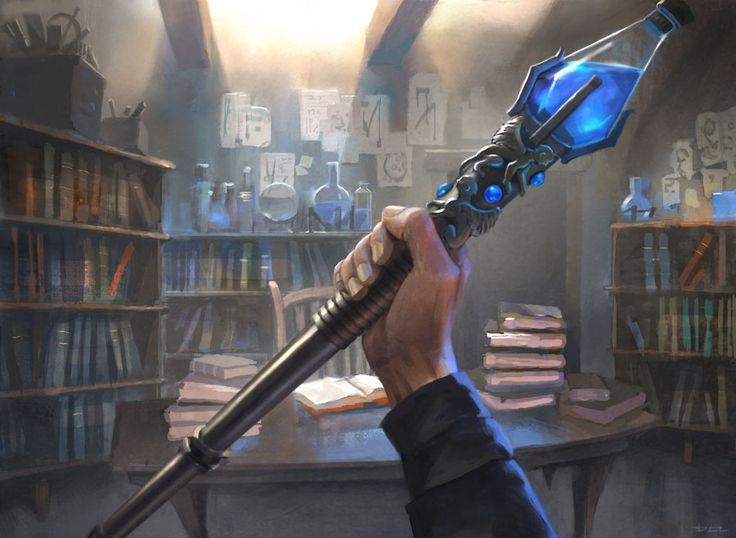Identify (spell)
Identity reveals the nature and purpose of mundane or magical items that the caster touches or handles. Once the spell is active, the caster is shielded from any effects or powers the item may possess, ensuring that its properties can be examined without risk.
| Range | touch |
| Duration | 1 round per level |
| Area of Effect | 1 item |
| Casting Time | 5 rounds |
| Saving Throw | none |
| Level | mage (1st) |
All items have a place of origin, a function and a previous owner or maker. Some items may also carry risks for those who use them, known as malevolent effects. For each round that the spell remains active, there is a chance of uncovering one piece of knowledge about the item being examined. This chance is determined by a base 15% success rate, increasing by 5% per caster level, and is rolled separately each round. If the roll fails, nothing is revealed during that round.
Any given item may possess special properties, including unique powers, intended purposes, hidden dangers or specific circumstances related to its existence. The caster has a number of chances to discern these details equal to their caster level, with each round offering a new roll to determine success. The chance of uncovering each detail follows the formula 15% + 5% per level of the caster. As before, a failed roll provides no new information for that round.
- For example, a 5th-level caster has a 40% chance per round to learn something about the item, with a total of five attempts. If the caster succeeds in three out of five rolls, then three separate details about the item are successfully revealed.
Artifacts are subject to the identify spell like any other object. While artifacts are often treated as exceptional in AD&D, and some possess unique resistances or unusual activation methods, there is no blanket rule stating that spells — including Identify — automatically fail or are ineffective when used on them. The fact that these objects are shrouded in secrecy is irrelevant; but because they do have so many powers, it would require a high level wizard using identify to discover them all by this method.
Revealed Properties
The Identify spell does not randomly reveal different properties with each casting — it follows a fixed order, meaning that repeated castings will continue to reveal the same initial properties until additional successful rolls allow the caster to push further into the object's hidden nature.
- For example, Aris, a 10th level mage, casts Identify on an unknown magical scepter. He has ten rounds to attempt to learn its properties, and with his level, he has a 65% chance per round to reveal one piece of information. During this first casting, Aris succeeds on seven out of ten rolls. This means he learns seven properties of the scepter, which are revealed in a particular order. Later, he casts identify again, to see if he can learn more; this time, however, he succeeds on four rolls before the spell ends. However, because the spell does not reveal properties randomly, these four successful rolls only confirm the first four details he already learned. The spell does not skip ahead to reveal new knowledge unless the mage surpasses his previous progress with additional successful rolls.
This maintains the power of higher level casters to successfully identify the properties of more difficult items like artifacts, while not artificially changing the premise of the spell.
Order of Knowledge Given
The strict progression of details about an object are given below. Details about each category must be fully known before progressing to the next, preventing the spell from skipping over more mundane information.
- 1. Dangers. These are always the most pressing concern; this includes curses, malevolent effects or harmful side effects, whether they take effect immediately or over time. The most dangerous aspect of an item is learned last — but of course, if any power is learned, then the caster can be sure all dangerous effects are known. If an item compels the user to act in a certain way, drains life force or otherwise harms the bearer, these effects are the first to be uncovered. Therefore, if anything is learned about the object, that it is safe to use is the most likely.
- 2. Powers. This begins with the least formidable ability and moving upward in potency. If the item operates on a limited number of charges or has restrictions on daily use, this is the first aspect to be learned. A weapon's bonus to attack & damage is always revealed before any special properties. Only after the base properties are known will additional abilities be uncovered, such as a sword being a flame tongue or possessing an increased bonus against reptiles, giants, dragons or other specific creatures.
- 3. Intended Purpose. Once the functional aspects are revealed, the caster gains full knowledge of the item's intended purpose, treated as a single piece of information. This includes whether the object was designed for war, for ritual, for divine use or for any other specific role determined by its creator.
- 4. History. This is also provided as a single piece of information. It includes the item's last known owner, along with information about where and when it was last lost or separated from its wielder. This detail may be particularly useful in uncovering the item's history, legend or connection to a particular time or place.
- 5. Additional Properties. Finally, once all practical and historical knowledge has been revealed, any other details of significance may be learned. This could include unique craftsmanship, hidden inscriptions or properties that do not fit within the previous categories but are still relevant to understanding the item. These are treated as individual things, but should be important enough to warrant this knowledge being given.
